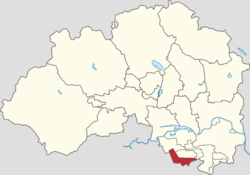Huilongguan Subdistrict
Huilongguan Subdistrict
回龙观街道 | |
|---|---|
 Huilongguan Sport Park, 2011 | |
 Location of Huilongguan Subdistrict within Changping District | |
| Coordinates: 40°03′48″N 116°19′06″E / 40.06333°N 116.31833°E | |
| Country | China |
| Municipality | Beijing |
| District | Changping |
| Village-level Divisions | 23 communities 2 villages |
| Area | |
• Total | 9.2 km2 (3.6 sq mi) |
| Elevation | 47 m (154 ft) |
| Population (2020) | |
• Total | 166,074 |
| • Density | 18,000/km2 (47,000/sq mi) |
| Time zone | UTC+8 (China Standard) |
| Postal code | 102208 |
| Area code | 010 |
Huilongguan Subdistrict (simplified Chinese: 回龙观街道; traditional Chinese: 回龍觀街道; pinyin: Huílóngguān Jiēdào) is a subdistrict situated within the 6th Ring Road and Changping District, Beijing, China. It borders Shigezhuang, Longzeyuan and Huoying Subdistricts in its north, Xisanqi Subdistrict in its east and south, Dongsheng Town and Qinghe Subdistrict in its south, and Xibeiwang Town in its west. Its total population was 166,074 in the 2020 census.[1]
This region used to host a Taoist temple named Xuanfu Palace, which was constructed under the mandate of Hongzhi Emperor in 1504. After its completion in 1516, the temple served as a stopping point for Ming emperors on their way to hold memorial services for their ancestors. Since Chinese emperors were often referred to as Chinese dragons, the temple and the region surrounding it later earned the name of Huilongguan (Chinese: 回龙观; lit. 'Returning Dragon Temple').[2]
History
[edit]| Year | Status | Belonged to |
|---|---|---|
| 1983–1990 | Huilongguan Township | Changping County |
| 1990–1999 | Huilongguan Town (Integrated Shigezhuang Township in 1999) | |
| 1999–2004 | Changping District | |
| 2004–2015 | Huilongguan Area | |
| 2015–present | Huilongguan Subdistrict (northern portions formed Longzeyuan and Shigezhuang Subdistricts) |
Administrative divisions
[edit]As of the year 2021, Huilongguan Subdistrict consisted of 25 subdivisions, with 23 of them being communities, and the other 2 being villages:[4]
| Administrative Division Code | Subdisvision Names | Name Transliteration | Type |
|---|---|---|---|
| 110114011001 | 龙博苑 | Longboyuan | Community |
| 110114011002 | 万润家园 | Wanrun Jiayuan | Community |
| 110114011003 | 龙城 | Longcheng | Community |
| 110114011004 | 万龙 | Wanlong | Community |
| 110114011005 | 东村家园 | Dongcun Jiayuan | Community |
| 110114011006 | 龙乡 | Longxiang | Community |
| 110114011007 | 吉晟别墅 | Jisheng Bieshu | Community |
| 110114011008 | 南店 | Nandian | Community |
| 110114011010 | 金榜园 | Jinbangyuan | Community |
| 110114011011 | 新康园 | Xinkangyuan | Community |
| 110114011012 | 龙兴园 | Longxingyuan | Community |
| 110114011013 | 龙兴园北区 | Longxingyuan Beiqu | Community |
| 110114011014 | 瑞旗家园 | Ruiqi Jiayuan | Community |
| 110114011015 | 二拨子 | Erbozi | Community |
| 110114011016 | 蓝天嘉园 | Lantian Jiayuan | Community |
| 110114011017 | 回龙观新村 | Huilongguan Xincun | Community |
| 110114011018 | 融泽家园一区 | Rongze Jiayuan Yiqu | Community |
| 110114011019 | 融泽家园二区 | Rongze Jiayuan Erqu | Community |
| 110114011020 | 金域华府 | Jinyu Huafu | Community |
| 110114011021 | 金域国际 | Jinyu Guoji | Community |
| 110114011022 | 融泽家园三区 | Rongze Jiayuan Sanqu | Community |
| 110114011023 | 新龙城西区 | Xinlongcheng Xiqu | Community |
| 110114011024 | 新龙城东区 | Xinlongcheng Dongqu | Community |
| 110114011201 | 回龙观 | Huilongguan | Village |
| 110114011202 | 二拔子 | Erbazi | Village |
Gallery
[edit]-
Huicheng Road on the north of the subdistrict, 2010
-
Huilongguan School of Beijing No. 161 High School, 2022
-
Buildings in Huilongguan, 2022
References
[edit]- ^ "北京市昌平区第七次全国人口普查公报". bj.bjd.com.cn (in Chinese (China)). Retrieved 2022-10-18.
- ^ "回龙观的由来". 2011-02-11. Archived from the original on 2011-02-11. Retrieved 2020-07-01.
- ^ 李立国; 李万钧; 吴世民, eds. (2013). 中华人民共和国政区大典, 北京市卷. Beijing: 中国社会出版社. ISBN 978-7-5087-4058-4. OCLC 910451741.
- ^ "2021年统计用区划代码和城乡划分代码". www.stats.gov.cn. Retrieved 2022-10-18.





